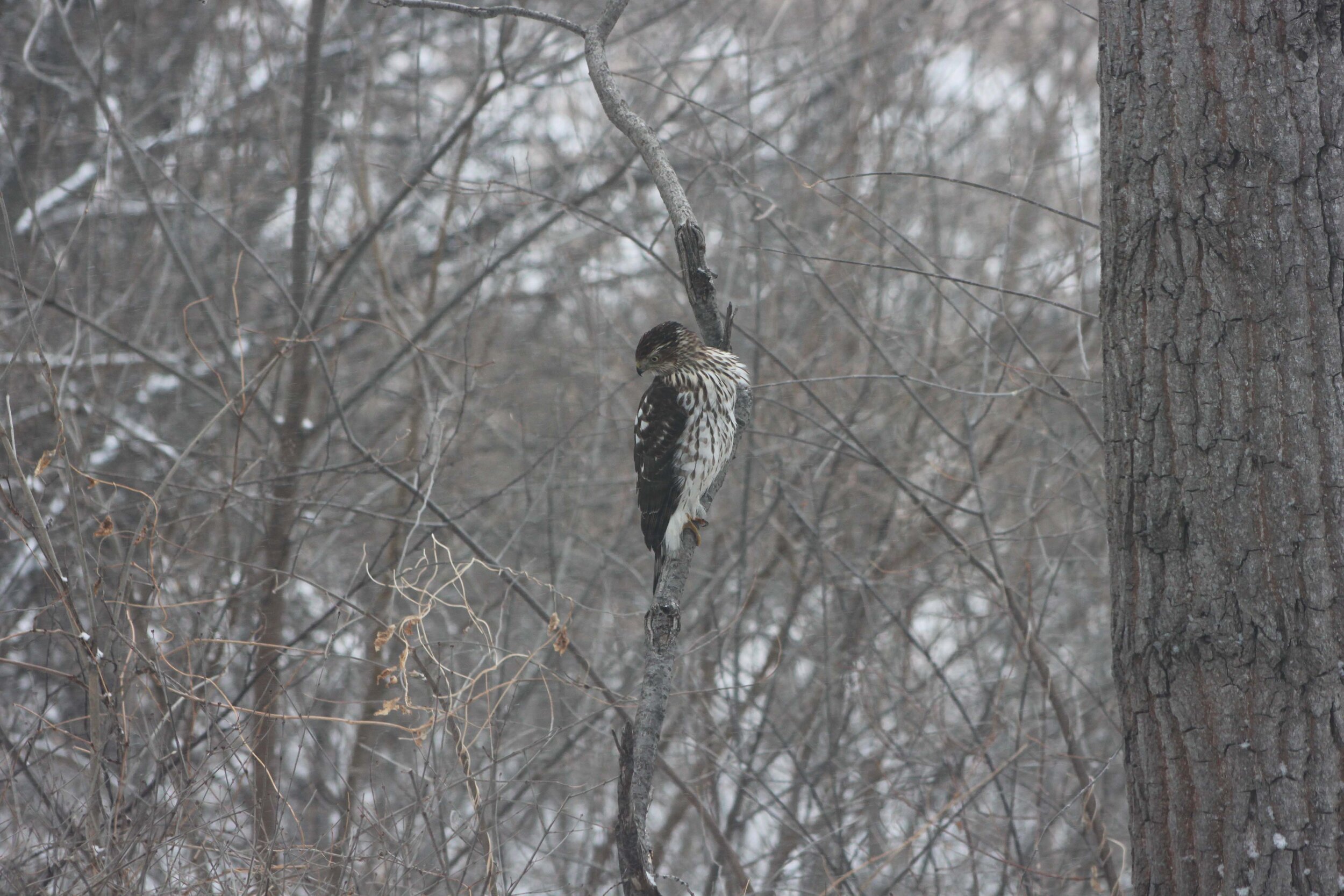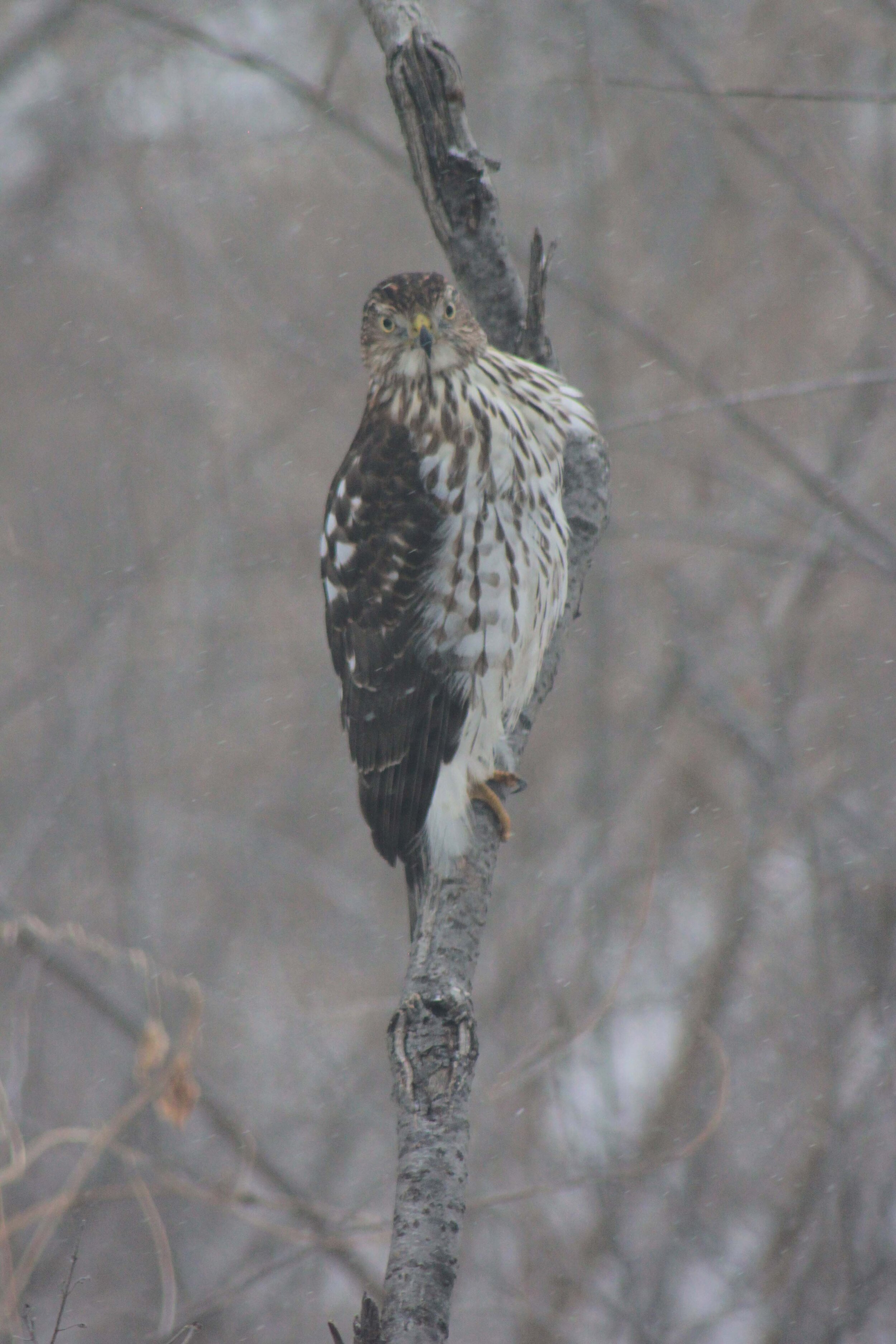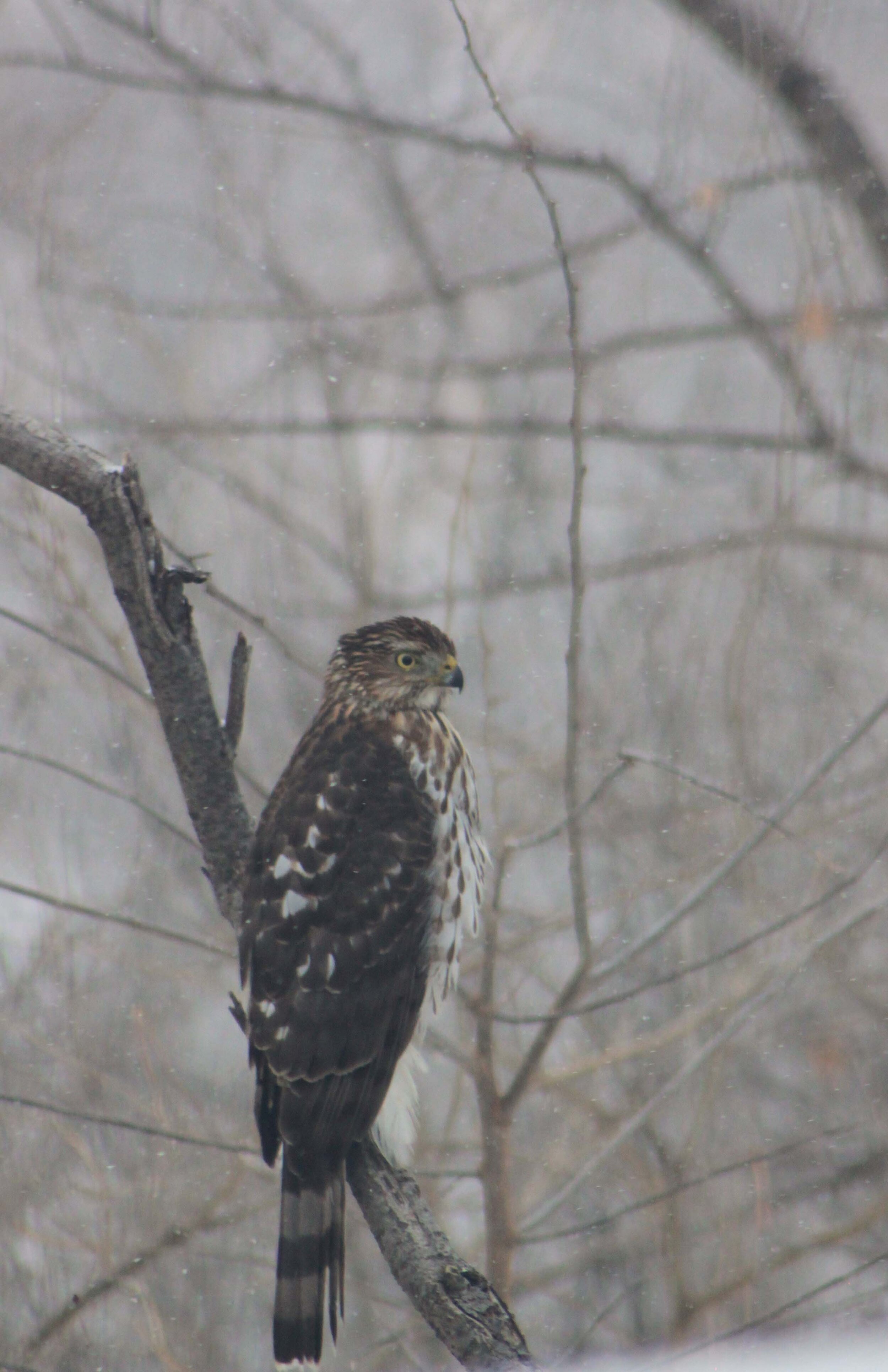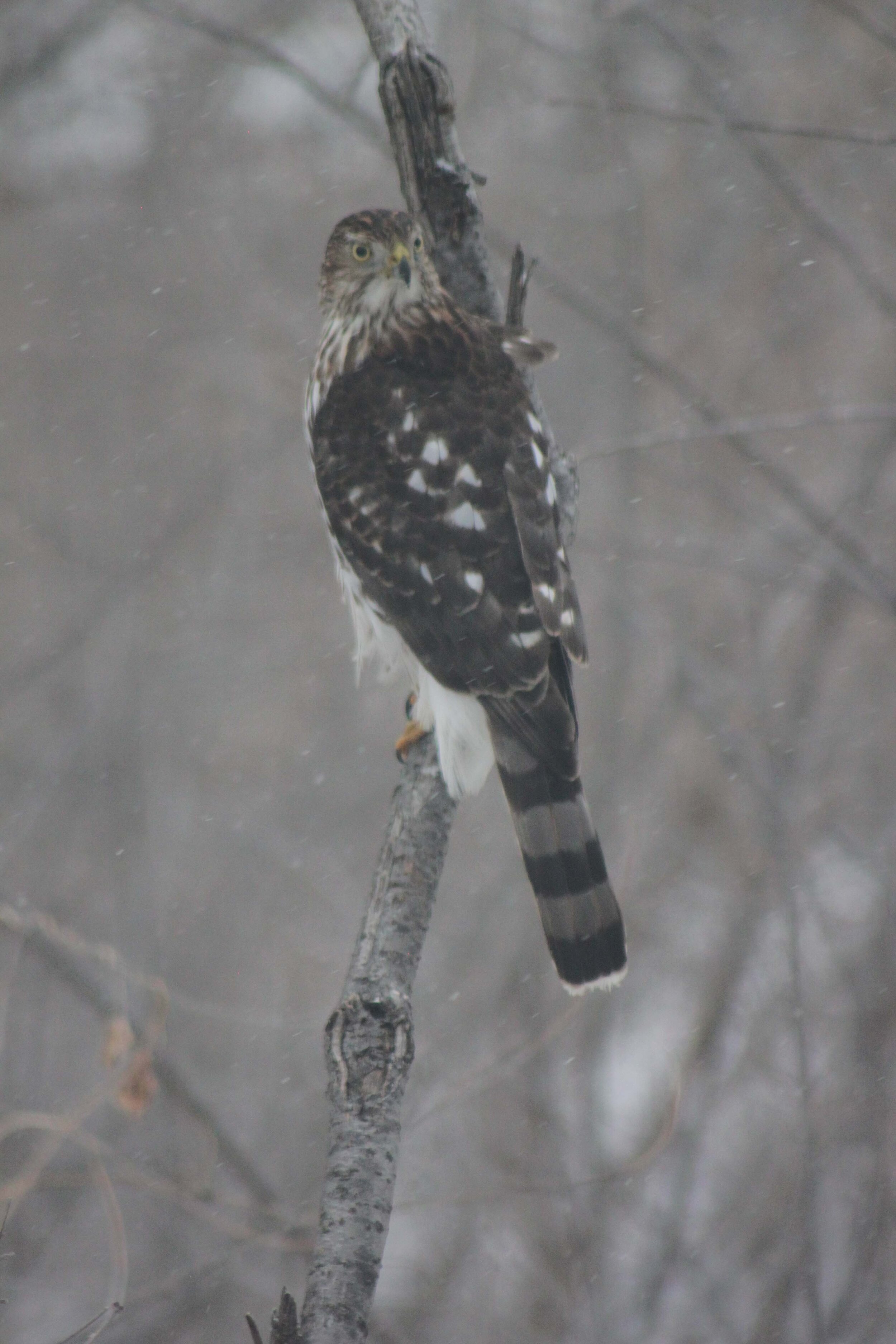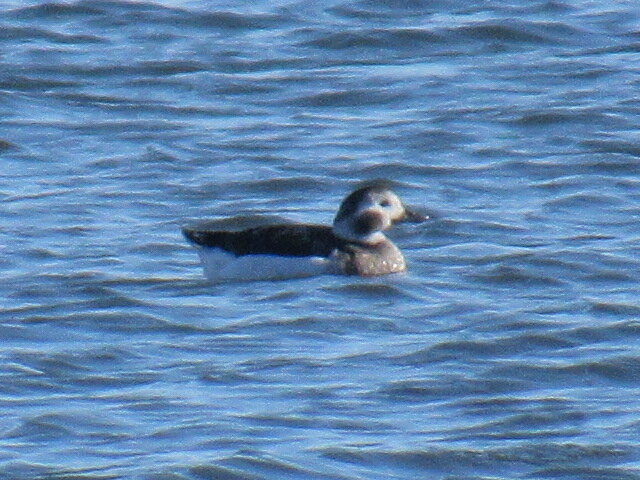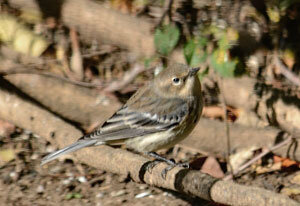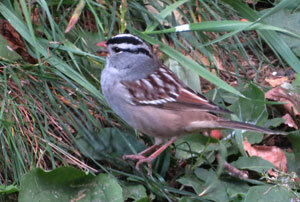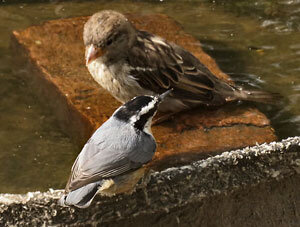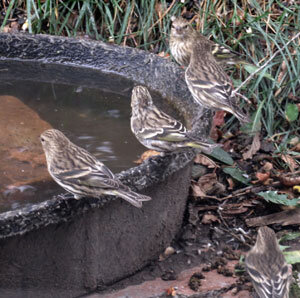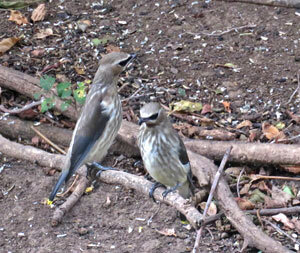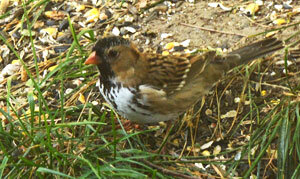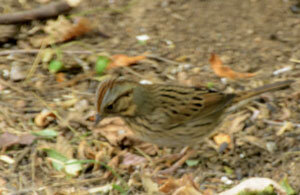bird sightings in our area:
LHAS Bird Hotline, Saturday, 30 December 2020
Bobwhite image copyright 2020 by Carol Blair, used with permission
I haven't had quail at the feeders for a couple of decades so what a surprise to see these. There were 7 total. I'm hoping that they will return now that they have found the feeders. I was hearing Bobwhites calling most of the summer so glad to see they are still around.
Carol B., Bronson, Iowa
Bobwhite image copyright 2020 by Carol Blair, used with permission
LHAS Bird Hotline, Saturday, 30 December 2020
Yesterday I had a visitor. I watched him for probably 10 minutes and shockingly he never tried to get a snack, got a few pictures but through the window, the clarity isn’t the greatest. Rob thought Coopers over Sharp shinned. All images copyright 2020 by Dustin Livermore, used with permission.
Dustin L., Sioux City
LHAS Bird Hotline, Sunday, 27 December 2020
5-Ridge Prairie, Plymouth County
Townsend's Solitaire, 1 (first found on 12/16 by J. Probst, but not seen since) Very few other birds
Iowa Highway-12, Plymouth County
Mourning Dove, 2
Stone State Park, Woodbury County
Pileated Woodpecker, 1 (thought to be residents, but seldom seen.)
Jerry P., South Sioux City, NE and Bill H., South Sioux City, NE
LHAS Bird Hotline, wednesday, 16 december 2020
Woodpecker image copyright 2020 by Maria Rundquist, used with permission.
Hairy (left) and Downy (right) Woodpecker at the feeder.
Maria R., Sioux City, IA
LHAS Bird Hotline, tuesday, 15 december 2020
Crystal Cove
The lake is 100% frozen except the extreme north end that is being kept open by approximately 400 Canada Geese. Today, they were joined by approximately 135 Snow Geese roosting on the ice. At least 3 Cackling Geese associated with the Canada Geese.
Bill H., South Sioux City, NE
LHAS Bird Hotline, friday, 11 december 2020
South Ravine Park, Sioux City, IA
Winter Wren, 2; one near west end; other, near east end.
Cedar Waxwings, 9 at group home on north side of Lincoln Way, eating crab apples.
American Robin, 9, also in crab apples.
Brown Creeper, 1
Jerry P., South Sioux City, NE and Bill H., South Sioux City, NE
LHAS Bird Hotline, thursday, 10 december 2020
County Road L12 between Smithland and Rodney, IA
Approximately 25 trumpeter swans seen in field today.
Sharon P., Monona County, IA
Blue Lake, Onawa, IA
20 swans on the northwest part of Blue Lake, west of Onawa, IA.
Doug C., Onawa, IA
LHAS Bird Hotline, Saturday, 5 december 2020
Barred Owl spotted in a dead tree on our property this morning (12/05/2020) approximately 25-30 yards from our house.
1 mile Northeast of Jefferson, SD / Hwy 12 bridge - (2) immature bald eagles spotted from our deck.
Sitting on our woodpile 15 feet from our 6 bird feeders - (1) Cooper’s Hawk
Jon N., Plymouth County, IA
LHAS Bird Hotline, friday and Saturday, 4 and 5 dec 2020
Union Grove State Park, Union County, SD, Saturday Dec 5, 2020
Red-shafted Flicker, 1 Red shafted wing linings, red moustache
Sharp-shinned Hawk, 1
Brown Creeper, 3-4
Dark -eyed Junco, 1 cismontanus, with Slate-colored.
Jerry P., South Sioux City and Bill H., South Sioux City
4 December, 2020, South Ravine, Sioux City, Woodbury County, Iowa
1 Winter Wren (FOY) (west end of South Ravine)
1 Carolina Wren (west end of South Ravine)
4 December, 2020, Owego Wetlands, Woodbury County, Iowa
1 Short-eared Owl (a probable 2nd one on a sign in the dark flew away)
2 Great Horned Owls (perched on small trees in the prairie--could be scaring Short-eareds away?)
2 Northern Harriers
24 Ring-necked Pheasants
(Appeared to be a large Falcon on the big dead tree by big water but too far to ID)
3 December 2020
1 Brown Creeper in back yard
Jerry V., Sioux City, Woodbury County, IA
LHAS Bird Hotline, monday, 30 nov 2020
On Mon, Nov 30, 2020 at 11:23 AM: out my backyard window
1 Carolina Wren
Jerry V., Sioux City, Woodbury County, IA
Monday, Nov. 30, 2020, 11 am: Kramper Lake highlights:
Trumpeter Swan, 8 adults
Eared Grebe, 1 basic
Northern Flicker, 1 hybrid female with salmon-colored wing linings, brown face and pale crescent on nape.
Red-breasted Nuthatch, 1
Pine Siskin, 1
Jerry P., South Sioux City, NE and Bill H., South Sioux City, NE
Monday, Nov. 30, 2020, 4:40-5:20pm: Owego Wetland Complex highlights:
Great Horned Owl, 1
Northern Harrier, 2
Bill H. and Regie B., South Sioux City, NE
LHAS Bird Hotline, wednesday, 25 nov 2020
Walking out to my deer stand tonight I thought some smartass put an old owl decoy on my seat. It moved! I walked right under it. A very pale West Taiga great horned owl! If it wasn’t for the ear tufts I might have thought it was a snowy. Western GH owls are much more tolerant of people also. It flew about 20 yds and sat there for almost all of the time I was there. Not a speck of brown on it. Wish I brought a camera.
Bill Z., Plymouth County, IA
Saturday, 21 November 2020, Ponca State Park, Dixon County, NE
Highlights at the following sites:
Feeders at the Resource Center:
Pine Siskin, approximately 6
Creekside Picnic Area with pedestrian bridge:
Winter Wren, 1
Highland Road:
Northern Saw-whet Owl, 1 heard previous night by Brogies
North unit of park:
White-crowned Sparrow, 1 adult, 2 juvenile
Mark & Ed B., Jerry P. & Bill H.
LHAS Bird Hotline, 14 nov 2020
Hi,
Friday a friend and I headed to Yankton, S.D. to record the Mandarin Duck that has been there for about 10 days now. This is an Asian species, and rarely seen in the United States. We were able to find the small city park near the Avera Hospital and record images of the out-of-this-world multi-colored duck.
Don P., Ida County, IA
Mandarin Duck and Wood Duck image copyright 2020 by Don Poggensee, used with permission
Bald Eagle discussion image copyright 2020 by Paul O. Roisen, used with permission.
LHAS Bird Hotline, 12 nov 2020
Headed over to Kramper Lake in Dakota County after seeing Bill H. and Jerry P. post (below).
Did not arrive until 4:26 PM, bad timing as I had spaced off how quickly it gets dark now. Missed Long-tailed Duck but picked up 14 species of waterfowl, 4 year birds (Brewer's Blackbird, Cooper's Hawk, Bufflehead, and Eared Grebe-which really shows the sad state of my year list), and a Dakota County bird (Brewer's Blackbird) so it was a really nice 31 minutes of birding: https://ebird.org/checklist/S76177004.
Photos of only things in the sunlight today. Distant less than optimal photos but what a size comparison between male and the considerably larger bulkier female. Things looked pretty good when I arrived but a spat broke out. They were discussing something pretty intensely at times. I think the male may have lost this discussion.
God Bless, Paul R., Woodbury County, IA
Long-tailed Duck image copyright 2020 by William F. Huser, used with permission.
LHAS Bird Hotline, 12 nov 2020
Wednesday, Nov 11, 2020
I Ave. south of NE-35:
Lapland Longspur, flocks of 25 and 50
Horned Lark, 4 or 5 mixed in with each flock of longspurs
Thursday, Nov 12, 2020 at 8:26 AM
Kramper Lake:
Long-tailed Duck, 1 adult female
Red-breasted Merganser, 5 females
Eared Grebe, 4 in basic plumage
Plus over 12 species of waterfowl.
Jerry P., South Sioux City, NE Bill H., South Sioux City, NE
Surf Scoter image copyright 2020 by Rob Towler, used with permission
LHAS Bird Hotline, 2 nov 2020, bacon creek park, sioux city, iowa
There was a Surf Scoter hanging around 2 Ruddy Ducks at Bacon Creek on Monday 11/2.
Rob T.
Nebraska Bird Hotline Report, 29 oct 2020
Yesterday my yard provided twenty species, including the junk birds. Not bad for this time of year. I finally had my first fall Tree Sparrow.
Harris’s Sparrow - 5
Northern Cardinal
Red-bellied Woodpecker - 1 female
Hairy Woodpecker - 2 (pair)
Downy Woodpecker - 1 make
Northern Flicker - pure red-shafted
White-breasted Nuthatch
Dark-eyed Junco -7
American Tree Sparrow - 1
Clay-colored Sparrow - 5
American Goldfinch - 1 (they’re slow coming in to the feeders this fall)
Mourning Dove
Eurasian Collared-Dove
Common Grackle -1
Killdeer - 1
Sharp-shinned Hawk
Bluejay - 8
Jan J., Wakefield, NE
lhas Bird Hotline, 28 October 2020, Kramper Lake, Dakota County, Nebraska
During a brief visit to Kramper Lake:
Trumpeter Swans, 2
Ring-billed Gull, 3
additional Scoter species, perhaps
Jerry P., South Sioux City, NE
lhas bird hotline, 28 october, moorhead park, ida county, iowa
While checking for Saw-whet Owls this morning I got to see two Long-eared Owls in Moorhead Park. No sighting of Saw-whets the last three days.
Don P., Ida County, IA
LHAS Bird Hotline, 25 oct 2020, snow fun!
Crystal Cove: Osprey, 1
Kramper Lake:
Surf Scoter, 1 im.
Eared Grebe, 1 basic plumage
200th at Rohde farm:
Black-billed Magpie, 2; overflight only, ID by size, strong flight and long tails.
I Ave:
Merlin, 1, F. c. richardsonii
Northern Harrier, 4
American Pipit, 60; attracted to plowed highway for foraging
Rusty Blackbird, 2 males, possibly more females
Jerry P., South Sioux City, NE Bill H., South Sioux City, NE
LHAS Bird Hotline, 24 oct 2020, morningside residence, sioux city, iowa
Just had a Carolina Wren in the shrubberies in the front of our house. One of our (safely indoor) cats spotted the movement before I did. It had a very distinct white eyebrow and was larger than a House Wren. Cream-ish color to the breast and sides with reddish-brown on the back.
Randy W.
Nebraska Bird Hotline Report, 23 October 2020, Kramper Lake (Danish Alps SRA) Dakota County, Nebraska
Headed over to look for Western Grebe (NOT seen), Ross's Goose (NOT seen) but did pick up late Clay-colored Sparrow, 3 Red-breasted Nuthatch, Common Loon, Horned Grebe. Greater White-fronted Geese and 114 American White Pelicans were flyovers. 43 species for the 2 hours I was there. Some nice cooperative birds for photos even with poor lighting and wind. The ebird list is below:
https://ebird.org/checklist/S75259949
Paul R., Woodbury County, IA
Nebraska Bird Hotline Report, 20 oct 2020
For the past two days I’ve had a pure Red-shafted Northern Flicker on my feeders. He was still here at dusk so I’m assuming he’ll be here in the morning.
On Monday during the snow I went to town for groceries and came upon a flock of 200+ Brown-headed Cowbirds. Largest flock I’ve ever seen this late in the season and the first since late August. Then, just south of the house there was a flock of approximately 100 Killdeer.
We went to Sioux Falls this morning and as always go across country the first half of the drive. Along the road by Powder Creek there was a mixed sparrow flock: Harris’s - 20+, White-crowned -2, White-throated - 1, Song - 1, Lincoln’s - 1.
Jan J., Wakefield, NE
lhas bird hotline, 20 and 24 october, moorhead park, ida county, iowa
Saw-whet Owl image copyright 2020 by Don Poggensee, used with permission.
This morning (10/20) the first Northern Saw-whet Owl was found and photographed here in Moorhead Park, Ida County. In the past we have found several in October, but most were here only the day they were found. With the migration on now, this one also, may be flying south after dark tonight.
Today (10/24) we had four, as the migration is on.
Don P., Ida County, IA
LHAS Bird Hotline, 19 and 20 oct 2020, kramper lake, dakota county, nebraska
Monday, Oct. 19, 2020:
12 species of waterfowl
Western Grebe, 1
Horned Grebe, 3
Common Loon, 2; one in recognizable alternate plumage, 1, in basic
Barn Swallow, 4
American White Pelican, 13
Bill H., South Sioux City, NE
Tuesday, Oct. 20, 2020:
14 species of waterfowl, the highlight being: Surf Scoter, 1 female or immature
First of Season (FOS) waterfowl included Bufflehead and Canvasback.
Plus notables Common Loon, 2; Western Grebe, 1
Jerry P., South Sioux City, NE and Bill H., South Sioux City, NE
Nebraska bird hotline, 19 october, Arctic and Common Terns and Lesser Black-backed Gull
These three birds we’re all seen at the Gavins point dam at one point in South Dakota also in the Knox County Nebraska all are continuing birds
Paul R.
Arctic Tern image copyright 2020 by William F. Huser, used with permission.
LHAS Bird Hotline, 15 and 16 oct 2020, gavin’s point dam, yankton, south dakota
On Thursday, 10/15, Mark Brogie found an Arctic Tern near the marina of Lewis & Clark Lake at the SD end of Gavin's Point Dam. The bird is transitioning from juvenile to first winter plumage and closely resembles a Common Tern of that age. Distinguishing field marks include very short legs which are easily seen when the bird roosts on the marina's jetty (which is drivable) and white secondaries in flight.
If looking for this bird, drive onto the marina's jetty to its end and look for the bird either roosting on the jetty or hunting over the eastern portion of the marina.
The bird was seen by several birders today, Friday, the 16th.
Jerry P., South Sioux City, NE; Bill H., South Sioux City, NE
october visitors, from a private residence near Bronson, iowa
All birds except the nuthatch arrived within 3 days. Most are still here at least for now. Most of them drink from the bird bath but don't show much interest in the seed. The pasture area has a lot of food for them so I expect they are there most of the time. There are also a crab apple tree and a larger apple tree near the cedar tree that they feed on.
All below images are copyright 2020 Carol Blair, used with permission.
Yellow-rumped Warbler - Have seen others in the shrubs and trees.
White-crowned Sparrow.
Red-breasted Nuthatch - I saw one earlier but it or another has been present on two more occasions.
Pine Siskin - A small flock that showed up
American Robin - Many, many all over the hill. They are busy in a large cedar tree that is loaded with berries.
Cedar Waxwing - Not sure of numbers but active at the above mentioned cedar tree.
Harris’s Sparrow - Two are steady customers
Lincoln’s Sparrow - Only seen once so far. It was busy looking for something to eat but seemed nervous about all the bigger birds flying back and forth.
Dark-eyed Juncos are also present but they were scared off before I got the camera set up!
Nebraska Bird Hotline Report, 4 and 6 oct 2020, dakota county, Nebraska
Kramper Lake, Dakota County (Sunday, 4 Oct):
Nelson's Sparrow, 5, perhaps many more
LeConte's Sparrow, > 4.
White-crowned Sparrow, 1 ad. Gambles, 1 im.
I Avenue, Dakota County (Tuesday, 6 Oct):
Krider's Red-tailed Hawk, 1 im.; whitish head, pale barred tail, large square white panel on dorsal primaries.
Bill H., South Sioux City
Nebraska Bird Hotline Report, 2 oct 2020, from a Private Residence near Wakefield, Nebraska
Finally no wind so I took a walk around the buildings this morning and ended with 21 species. Two First of Season (FOS) were nice.
| BIRD | BIRD | BIRD |
|---|---|---|
| Blue Jay | Clay-colored Sparrow | Yellow-rumped Warbler |
| American Robin | Lincoln's Sparrow | Field Sparrow |
| House Wren | Ring-necked Pheasant | Spotted Towhee (female) |
| Harris's Sparrow | White-throated Sparrow (FOS) | Dark-eyed Junco (FOS) |
| White-breasted Nuthatch | Hairy Woodpecker | House Finch |
| Red-tailed Hawk | Eurasian Collared-Dove | European Starling |
| Rock Pigeon | Common Grackle | House Sparrow |
LHAS Bird Hotline, 30 Sep 2020, South ravine park, sioux city, iowa
Too windy for much success at noon on Thursday 9/30. This guy sang a tune as I was getting in my vehicle to leave...even posed for a couple shots.
Rob T.
Red-breasted Nuthatch image copyright 2020 Rob Towler, used with permission
LHAS Bird Hotline, 28 Sep 2020, from a private residence near Bronson, iowa
Red-breasted Nuthatch image copyright 2020 Carol Blair, used with permission
A Red-breasted Nuthatch visited here today. It got a drink and left again. Also a pair of Chipping Sparrows have been feeding for the last couple of days. Saw a pair last spring but not since then so don't know if this is the same pair or a migrating pair.
Carol B.
Nebraska Bird Hotline Report, 28 sep 2020, from a Private Residence near Wakefield, Nebraska
I had a small mixed flock working over the apple trees this morning. Included were:
Chipping Sparrows
Yellow-rumped Warbler
No wrens today but there were two Lincoln’s Sparrow and one Song Sparrow. When I first went out I flushed a Cooper’s Hawk so the wrens may just have been under cover still.
18 species thus far today.
Sunday, Sept. 20, 2020, 7:15 am:
The Square, Woodbury County, IA:
Yellow-crowned Night Heron (YCNH), 1 juvenile (First found the previous day by the Loess Hills Audubon outing participants
Owego Wetlands, Woodbury County, IA:
Swainson's Hawk, 4 juv.
Jerry P., South Sioux City, NE and Bill H., South Sioux City, NE
YCNH image copyright 2020 by Willam F Huser used with permission
LHAS Bird Hotline, 18 Sep 2020, Woodbury County, Iowa
South Ravine 9/18 - Noon
8 – Nashville Warblers
2 – Flickers (Yellow-shafted)
2 – Carolina Wrens (Extremely cooperative)
Rob T.
Carolina Wren image copyright 2020 by Rob Towler, used with permission.
Owego Wetlands
Swainson's Hawk, 1 im
Sora, 2
Sedge Wren, 1
Marsh Wren, 1.
Dairy Pond on 280th
American Golden Plover, 1 basic
Sandhill Lake
Red-necked Phalarope, 1 juv.
New Lake
Stilt Sandpiper, 93
Jerry P., South Sioux City, NE and Bill H., South Sioux City, NE
Nebraska Bird Hotline Report, 17 sep 2020, from a Private Residence near Wakefield, Nebraska
This morning I had my first fall Red-breasted Nuthatch in the yard. He didn’t stay around long. Yesterday morning early I had two Hummingbirds. We’d been gone so I mixed some nectar and when cooled replaced the nectar. Never saw them again, but late afternoon I briefly had one at a feeder. I also found two Lincoln’s Sparrows, one Brown Thrasher and one House Wren.
LHAS Bird Hotline, 4 Sep 2020, Stone Park, Woodbury County, Iowa
Mid-morning at the first little round-about area (Dakota Valley) after entering west entrance: Pileated Woodpecker. I first heard loud calling and then saw it fly a couple times and land high in a tree. It continued to work the area and I heard the raucous calls many times and had brief views of it a few more times. It was working a wide area and went towards the west entrance of the park. It was huge. When I 1st saw it fly, I said, “Hallelujah!”--I'm sure. There were two of them because when it was calling, I could hear a second one from a different area.
Other birds of note:
2 Carolina Wrens
1 Yellow-billed Cuckoo
1 Scarlet Tanager
1 Wilson's Warbler
1 Nashville Warbler
1 Great-crested Flycatcher
Jerry V.
Nebraska Bird Hotline Report, 2 sep 2020, from a Private Residence near Wakefield, Nebraska
Not a bad day for early September. Thus far I’ve recorded 25 species for today’s yard bird total. Some of the more interesting:
Ruby-throated Hummingbird, 2 females and 1 male
Yellow, Nashville, Magnolia, and Wilson’s Warblers
Grey Catbird
Brown Thrasher
Baltimore Oriole - 2 males
Ruby-crowned Kinglet - FOS
Warbling Vireo
Several Barn Swallows discussing when best to leave here
Yesterday I had a Rose-breasted Grosbeak And an empidonax Flycatcher
Several Monarch butterflies and two female deer
Warbler Report, 1 Sep 2020, Bacon Creek Park, Sioux City
Although a few warblers, including Wilson's, Canada and Black and White, were in evidence last week, primarily at Bacon Creek Park, the best report of the season thus far was from Bacon Creek Park on Tuesday, Sept. 1, all in 40 minutes:
Blackburnian Warbler, 1 f.
Canada Warbler, 1 m.
Wilson's Warbler, 1 m.
Nashville Warbler, 3 im.
Black & White, 1 m., 1 f.
Am. Redstart, 1 m., 1 im.
Bill H. and Rob T.
from a private residence in Morningside
Just had an interesting combination of Red-breasted Nuthatch and Ruby-throated Hummingbird at the feeders, 7:45 PM, 8/16. We also had our usual suspects: House Finch, American Goldfinch, and Eurasian Collared-Dove.
Randy W.
Nebraska Bird Hotline Report, 28 Jul 2020, from a Private Residence near Wakefield, Nebraska
I had a nice surprise this morning. The first cuckoo of the year in the yard. The past several years I’ve had a Black-billed but today it was a Yellow-billed Cuckoo. He was singing for over an hour as I walked around, flying over me a couple times. Richard just said he heard him now north of the barn.
Bacon Creek Park in Sioux City, Woodbury County Iowa.
Surf Scoter (female in early morning darkness) - Bacon Creek Park by Rob Towler
On 11-1-2017, 2 local birders found a Surf Scoter at Bacon Creek Park in Sioux City, Woodbury County, Iowa and it was present for a couple days. The National Geographic Field Guide to the Birds of North America lists the Range of this bird as: nests on Tundra and in wooded areas near water—rare inland migrant—a few winter on Southern Great Lakes—most in Coastal waters. The Iowa Ornithologists Union lists this bird as a regular visitor to Iowa and it is most often seen during the months of October and November.
The Surf Scoter is a Sea Duck common on the Pacific and Atlantic coasts in winter. It migrates in flocks. When migrating overland to coastal wintering areas, usually flies high. Stopovers on lakes inland apparently are mostly for resting, not for feeding. This duck was a female which is not as colorful as the male but still a rare find in our area.
Owego Wetlands in Woodbury County Iowa.
Eurasian Wigeon - One of these was found at Owego Wetlands 4-17-2017
On 4-17-2017, 2 local birders found a Eurasian Wigeon at Owego Wetlands in Woodbury County, Iowa and it was present through 4-21-2017. The National Geographic Field Guide to the Birds of North America lists the Range of this bird as: Rare but regular winter visitor along both coasts, more common in the West, rare in interior of North America. Regular migrant in western AK, a few winter in the Aleutians. The Iowa Ornithologists Union lists this bird as an accidental visitor to Iowa. Several local birders were able to view this rare visitor to our area and it was a life bird for some and a first in Iowa bird for others. A few birders from other areas of the state also came to see this bird.
The Cornell Lab Of Ornithology states: Common and widespread in the Old World, the Eurasian Wigeon is a sporadic visitor to North America. Regular in very small numbers along the Pacific and Atlantic coasts, single individuals have turned up in nearly all states and provinces. This was an exciting bird to see for local birders and shows again that you never know what you might find while out birding!
Farm fields in Monona County, Iowa.
Burrowing Owl in Monona County, Iowa - By Paul Roisen
On 5-4-2016, local birders found a Burrowing Owl in a farm field Southwest of Sloan in Monona County, Iowa and it was present through 5-14-2016. It was using an abandoned Badger hole near a gravel road so was easy to see. Per the Cornell Lab Of Ornithology, Owls are unmistakable birds, and that goes double for a long-legged owl that hunts on the ground during the day. Burrowing Owls are small, sandy colored owls with bright-yellow eyes. They live underground in burrows they’ve dug themselves or taken over from a prairie dog, ground squirrel, or tortoise. They live in grasslands, deserts, and other open habitats, where they hunt mainly insects and rodents. Their numbers have declined sharply with human alteration of their habitat and the decline of prairie dogs and ground squirrels. The Iowa Ornithologists Union lists this bird as a casual visitor to Iowa.
Cemetery in Sheldon, IA.
Pine Grosbeak - Sheldon Cemetery by Paul Roisen
Red Crossbill and White-winged Crossbill - Sheldon Cemetery by Jan Null
During the winter of 2015-2016, Pine Grosbeaks, Red Crossbills, and White-winged Crossbills were found at a cemetery in Sheldon, IA. They were present for several weeks. Those 2 species of Crossbills were also found at Graceland Cemetery in Sioux City, IA. and were also present for several weeks.
Many local birders and out of town birders were able to see and enjoy these uncommon visitors to Iowa. Per the Cornell Lab Of Ornithology, the Pine Grosbeak is a bird of the boreal forests, found across northern Eurasia and North America, and south into the mountains of western Canada and the United States. A large, unwary finch, it makes periodic winter irruptions into southern Canada and northern United States. It is the largest and rarest of the "winter finches." The Iowa Ornithologists Union lists this bird as an accidental visitor to Iowa.
The Red Crossbill is described as a stocky finch of mature coniferous forests and is dependent on the seed cones that are its main food. Its peculiar bill allows it access to the seeds, and it will breed whenever it finds areas with an abundance of cones. It may wander widely between years to find a good cone crop. The White-winged Crossbill is described as a medium-sized finch of the boreal forest and is adapted for extracting seeds from the cones of coniferous trees. It moves large distances between years tracking the cone crop from place to place. The Iowa Ornithologists Union lists both of these Crossbills as regular visitors to Iowa, but it is always a treat to find them in our area extracting the seeds from the pine cones and then dropping the cones under the tree!
A flooded farm field in Woodbury County, Iowa.
Black-bellied Whistling-ducks by Jan Null
On 6-28-2014, local birders found 2 Black-bellied Whistling-ducks in a flooded farm field in Woodbury County, Iowa (about 2 miles west of Owego Wetlands) and they were present through 6-29-2014. Per the Cornell Lab Of Ornithology, these ducks are common south of the U.S. and occur in several southern states and are expanding northward. It is a boisterous duck with a brilliant pink bill and an unusual, long-legged silhouette. They roam edges of shallow ponds, frequent agricultural fields and really do have a whistle for their call. The Iowa Ornithologists Union lists this bird as a casual visitor to Iowa.
Badger Lake in Monona County, Iowa.
Cinnamon Teal with Blue-winged Teal - Badger Lake, Monona County 4-21-2014 by Jan Null
On 4-21-2014, local birders found a Cinnamon Teal at Badger Lake in Monona County, Iowa. Per the National Geographic Field Guide this bird is a westerly species and a casual visitor to our area. The beautiful Cinnamon Coloration of this duck certainly stands out when in the company of the abundant Blue-winged Teal that migrate through our area. Males have red-orange eyes and give a chattering call.
Stone State Park.
Worm-eating Warbler - By Tucker Lutter
On 5-13-2013, a local birder found a Worm-eating Warbler in the Pammel Valley area of Stone State Park. The park is located just northwest of Sioux City, Iowa. Per the National Geographic Field Guide the range of this bird is the southeastern United States and up to the Mississippi River area of eastern Iowa. It is found chiefly in dense undergrowth on wooded slopes and often feeds in clusters of dead leaves. It is a casual vagrant in California and the southwest. It has bold, dark stripes on a rich buffy head, upperparts brownish-olive; underparts buffy; long, spikelike bill. Song is a series of sharp, dry chip notes like Chipping Sparrows but faster. The bird was in the area for a few hours and viewed by several local birders but was not found in the next few days. This is thought to be only the 2nd sighting of this bird in Woodbury County.
2011 - 2013 REcords
WINTER 2012/2013 COMMON REDPOLLS IRRUPTION.
Common Redpolls have invaded Siouxland and the state of Iowa. Numerous flocks of various sizes have been seen locally during CBC’s (Christmas Bird Counts) and by individual birders at conservation areas such as the Owego Wetlands. People with niger and sunflower type feeders have also enjoyed finding this pretty little visitor with a red cap and black chin at their feeders. The male usually has a bright rosy breast and sides. Per the National Geographic field guide this bird breeds in subartic forests and tundra scrub. It forms large winter flocks and frequents brushy, weedy areas, also catkin-bearing trees like alder and birch. Its song combines trills and twittering.
FALL/WINTER 2011 SNOWY OWLS IRRUPTION!!
Snowy Owls have invaded Iowa and surrounding states! A few were sighted in November and the sightings have increased greatly in December. The Iowa Ornithologists’ Union (IOU) has been tracking the sightings reported by birders across the state of Iowa and attempting to the best of its ability to not count the same birds twice. As of Christmas day 2011, 61 Snowy Owls have been reported in Iowa. Sadly, there have also been some mortalities with 9 being reported through that same date. (Including one on old hwy 75 just north of Salix). The IOU Home Page at htttp://www.iowabirds.org/ contains a map of where the Owls have been reported in Iowa and where the mortalities have occurred.
This is a very unusual occurrence and birders across the state have been out taking advantage of the opportunity to see this magnificent visitor from the far north. There are years when none are seen this far south, and years when small irruptions of a few occur but this year has seen a large number in Iowa. Irruptions occur when the food supply is not sufficient for their survival, so they move south to look for food. It was reported that due to a recent good food supply there was a very good reproduction of the Owls and then the food supply crashed and now they have been forced to move south.
According to the National Geographic Field Guide, Snowy Owls are an Owl of open tundra; nests on the ground; preys chiefly on lemmings, hunting by day as well as at night. It is a large white Owl with yellow eyes. Dark bars and spots are heavier on females, heaviest on immatures. Old males may be pure white. A bird of the Artic Tundra, it retreats from northernmost part of range in winter. In years when the lemming population plummets, Snowy Owls may wander in winter as far south as northern Alabama, Oklahoma and central California. These irruptives, usually heavily barred younger birds, often perch conspicuously on the ground or on low stumps, fence posts and buildings. (In Iowa they seem to also like hi-line poles and round grain bins).
Several have been seen locally in Woodbury County with up to 5 seen in a small area and perhaps at least a dozen or more overall in Woodbury. Local birders have been out taking advantage of this rare opportunity and other birders from across the state have come to our area also. Most of those seen have been immatures but a couple have shown the almost white coloring of an adult. This is indeed a good time to enjoy this beautiful bird from the far north! Who knows when it will return again??
July/August 2011--BLACK-NECKED STILTS.
On 21 July, Black-necked Stilts were spotted in a flooded corn stubble field along Nebraska Highway 35 east of Hubbard, Dixon County, NE. Several local birders were able to see their first local stilts and to eventually locate up to 9 adult birds, two incubating pairs, one nest with 4 eggs and a lingering pair with a juvenile on 6 August, which was later found to be 2, and then 3 juveniles by 27 Aug.
These precocial young leave the nest immediately upon hatching and feed themselves under the watchful eyes of the vigilant parents, who were observed driving away Killdeer, Lesser Yellowlegs and Red-winged Blackbirds. Expected to fledge at 28-32 days, the young, when they were about 25 days old, were under the watch of one adult, the other suspected of beginning migration as did the other 7 adults in mid August, typical for the species.
These stilts were found in an area that would normally be covered with corn and beans, but due to The Great Missouri River Flood of 2011 the corn and bean fields had been obliterated and another habitat seldom seen in the Missouri River floodplain in late summer was created, that being the flooded row crop and pasture ground in the lower elevations of the floodplain. These flooded, playa type wetlands provided an enticement for an unprecedented breeding attempt by Black-necked Stilts, usually spending their summers in distant western alkali playas or coastal locations.
Per the National Geographic Field Guide, the Black-necked Stilt is a more westerly and southern species. The male’s glossy black back and bill contrast sharply with white underparts and long red or pink legs. It breeds and winters in a wide variety of wet habitats. Its breeding range is spreading north and it is casual north to Great Lakes.
2011 OSPREY NEST ACTIVITIES
A pair of Osprey have returned to both nests south of Sioux City.
The nest near Brown’s Lake in Woodbury County hatched 2 young but 1 seems to have disappeared. The 1 remaining young is good sized and has been seen exercising its wings and appears to be close to flying. This is the 4th year for this nest and it has produced a total of 8 young over the last 3 years.
The nest south of Sloan in Monona County hatched 3 young and all 3 are still present and accounted for. They are also good sized and one of them was seen standing in the nest and exercising its wings and appears to be close to flying. This is the 2nd year (as far as we know since it was discovered late last year) for this nest and it produced 2 young last year.
The nest near Brown’s Lake in Woodbury County has fledged 1 young and the nest south of Sloan in Monona County has fledged 3 young.
2010 and prior
12-07-2010
A Ross’s Gull was found at Gavin’s Point Dam in Yankton S.D. on November 26, 2010 and was still present as of 12-07-2010. This bird is very rare in our area. The National Geographic Field Guide to the Birds of North America states that the Ross’s Gull is an East Siberian Artic species. It is a common fall migrant along the northern coast of Alaska, presumably winters at sea, and is casual south to the northern U.S. Several birders from wide ranging areas of the U.S. have come to see this bird from the far north!
8-21-2010
3 Yellow-crowned Night-herons were found at Sandhill Lake in Woodbury County SW of Salix. Per the National Geographic Field Guide, this bird is a more southerly species and is a casual visitor to our area. These birds were juveniles and displayed striking red eyes.
An amazing number of 11 juvenile Yellow-crowned Night-herons were observed at this same sight on the evenings of 8-23-2010 and 8-24-2010!!
8-20-2010
A Second Osprey Nest Found In Our Area!
An Osprey nest was found south of Sloan in Monona County. There were 2 young and an adult at the nest. This nest is about 10 miles SE of the other Osprey nest near Brown’s Lake that has produced a total of 8 young over the last 3 years. This is most likely the 1st confirmed nesting of Osprey in Monona County since European settlement!
2010 Osprey Nest Activities
Due to safety concerns, the Osprey nest on the communications tower north of Brown’s Lake that fledged 3 young in 2008 and 3 young in 2009 was removed in the fall of 2009. The question was: will the Osprey pair return and nest in 2010? The answer is yes and their return and nesting activities are summarized below.
4-3-2010=A single Osprey was seen on the tower.
4-4&5-2010=An Osprey pair was observed at the site rebuilding the nest.
4-16-2010=Pair on nest--one flew and returned with a stick--the nest is looking better!!
5-4-2010=Was raining--could see head of one on nest--2nd one flew in with a small fish and was tearing it apart and eating it.
5-20-2010=Both adults on the nest--they appear to be sitting on eggs?
6-11-2010=Both adults on nest and 1 appeared to be feeding young.
6-22-2010=One adult on nest and one on tower--saw the dark heads of 2 good sized young!
7-14-2010=Both adults on tower--2 large young in nest preening.
7-20-2010=Both adults on tower and the 2 young are standing tall in the nest.
7-23-2010=Both adults on tower and 2 young on nest exercising their wings.
8-3-2010=The 2 young have fledged!
4 and 5 - 2010
On 5-11-2010, a beautiful Ruddy Turnstone in breeding plumage was found at a dairy pond north of Luton in Woodbury County. Per the National Geographic Field Guide, this bird nests on coastal tundra and is a rare inland migrant except in the Great Lakes region. Striking black-and-white head and bib , black-and-chestnut back, and orange legs mark this stout bird in breeding plumage. Turnstones use their slender bills to flip aside shells and pebbles in search of food.
A CINNAMON TEAL was found on 4-21-10. Per the National Geographic Field Guide, the Cinnamon Teal is a more westerly species. It is common in marshes, ponds, lakes, regular from eastern great plains south to east Texas, casual to eastern Midwest and east. This bird was a handsome adult male in cinnamon color with a red eye.
A BLACK-NECKED STILT was found on 5-8-10. Per the National Geographic Field Guide, the Black-necked Stilt is a more westerly and southern species. The male’s glossy black back and bill contrast sharply with white underparts and long red or pink legs. It breeds and winters in a wide variety of wet habitats. Its breeding range is spreading north and it is casual north to Great Lakes.
A LITTLE BLUE HERON was found on 5-11-10. It was an adult in breeding plumage. Per the National Geographic Field Guide, the Little Blue Heron is a more southerly species. In high breeding plumage head and neck become reddish-purple, legs and feet black. They are slow methodical feeders and disperse north in spring and during post-breeding dispersal.
January 2010
For the 2nd year in a row, a PRAIRIE FALCON was found near the dairy farm just south of Luton, IA., in Woodbury County. It was 1st seen on January 27th. Then on January 30th, Two Were Found in that area. One captured a starling and landed in a nearby field to feed and was joined by a 2nd one on the ground. They were still present into early March. The one found last year was 1st seen on February 12, 2009.
This bird is another welcome winter visitor to our area! Per the National Geographic Field Guide, it preys chiefly on birds and small mammals. It inhabits dry, open country, prairies and is a more westerly species. It is a rare migrant and winter visitor to the ‘western’ midwest. Falcons are powerful hunters and are distinguished from hawks by their long wings which are bent back at the wrist and narrow and pointed.
2009
On 11-17-2009 a Tufted Titmouse was found at a feeder in Bronson, IA. It was present at least until 11-23-2009. The National Geographic Field Guide states that this bird is active and noisy and its typical song is a loud whistled peter-peter-peter. This bird was certainly living up to its reputation. In its range it is common in deciduous woodlands, mesquite, parks, suburbs and feeders. Although commonly found in southern and eastern Iowa, it is a rare visitor to northwest Iowa and it was a life bird for Woodbury County for several of the birders who were fortunate to see it.
A beautiful, adult Scissor-Tailed Flycatcher was found in the town of Luton, IA on 10-25-2009 and was present through 10-26-2009. The National Geographic Field Guide states that this bird is found in semi-open country and is a rare to casual wanderer in much of North America. Its usual range is further to the southwest in the states of Kansas, Oklahoma, and Texas. This bird had colorful, salmon pink sides and was foraging in a grassy area near the road and put on quite a show flying and perching at times on the hi-line or hay bales or weed stalks. The last known STFC in Woodbury County was a juvenile found at the Owego Wetlands on October 2, 2006.
While viewing the Scissor-tailed Flycatcher on 10-26-2009 in Luton, IA., a beautiful, adult, Northern Goshawk was also found in the area perched in a nearby tree. The National Geographic Field Guide states that the NOGO inhabits deep conifer-dominated, mixed, woodlands and preys on birds and mammals as large as hares. Its normal range includes Canada and some western states. It is an uncommon, winter, visitor to our area.
On 10-25-2009 a large flock of Smith’s Longspurs were found at Luton Wildlife Area North. Up to 104 were counted at one time. The National Geographic Field Guide states that this Longspur nests on open tundra and damp tussocky meadows in the far north. It is generally uncommon and secretive, especially in migration and winter. It winters in open, grassy areas and this is the habitat it was found in at L.W.A. North. You can almost step on them before they fly and disappear again in the grass. They make a sharp, dry, ticking, rattle when flushed and their outer tail feathers are visibly white when flying.
May 2009, Woodbury County, IA
An OSPREY pair has returned to the nest near Brown's Lake where they nested and fledged 3 young last year. The pair was observed in early April adding nesting materials to last year's nest. In early May they appeared to be sitting on eggs, so we will watch and see if they are successfull in fledging more young again this year!
July 2009--3 young Osprey were confirmed in the nest!
Both adults were on the tower and the 3 young were in the nest! One of the young flew around the tower a few times and landed on the tower about 5 rungs below the nest. (It seemed to be having a hard time getting back up to the nest). A second young was exercising its wings and flying up above the nest just a short distance and coming back down into the nest. The 3rd young was hunkered down low in the nest most of the time but did come up higher in the nest later on. It is most likely the youngest of the 3.
August 9, 2009
All 3 young were present at the nest area. All 3 have been seen flying. It appears to be a successfull nesting with 3 young fledged for the 2nd straight year!
May 2009 Ida Co., IA
A SURF SCOTER was found in early May at Crawford Creek Recreation Area in Ida county. This rare inland migrant is rare in our area.
April 2009 Woodbury Co., IA
A SANDHILL CRANE was found in late April 2009, at Sandhill Lake which is an old oxbow southwest of Salix, IA. This bird is not commonly seen in our area.
April 2009 Woodbury Co., IA
A SNOWY PLOVER was found in late April 2009 at a dairy pond southeast of Luton, IA . This bird is rare in Iowa, but a second one was also seen about the same time in central Iowa. The National Geographic Field Guide shows the range of this bird further to the southwest and west when it migrates north during the summer.
March 2009, Sioux City, IA
A Carolina Wren has been a regular visitor to the feeders of a Sioux City residence for several weeks. It was first seen on November 11, 2008 and was still present on March 15, 2009. The National Geographic Field Guide states that the Carolina Wren is found in the concealing underbrush of moist woodlands and swamps and in wooded suburbs. It is non-migratory, but after mild winters, resident populations expand north of their normal range. After harsh winters, range limits retract. The range map shows it residing in the southeastern portion of the United States and up to the southern half of Iowa. It sings a loud vivacious, melodious song at any time of day or year.
Other local sightings of Carolina Wrens include Stone Park, South Ravine, and Ponca State Park, but it is unusual to have one at a feeder on a regular basis for such a long period of time. On March 5th, it was also heard singing its song several times. It is a little larger than the more common House Wren that migrates here to nest in the summer.
February 2009 Woodbury Co.,IA
A Prairie Falcon was found near the dairy farm just south of Luton, IA., in Woodbury County on February 12, 2009. It was 1st seen dive bombing and aggressively interacting with a Red-tailed Hawk. It later flew to the field to the west and perched on the ground. It then took off and flew to the dairy barns to the east and ‘strafed’ the thousands of starlings around the barns. It did not appear to be hungry as it seemed more like it was just ‘playing’ with them. This bird was still present on February 14 and may hang around awhile since it has a good food supply available.
This bird is another welcome winter visitor to our area! Per the National Geographic Field Guide, it preys chiefly on birds and small mammals. It inhabits dry, open country, prairies and is a more westerly species. It is a rare migrant and winter visitor to the ‘western’ midwest. Falcons are powerful hunters and are distinguished from hawks by their long wings which are bent back at the wrist and narrow and pointed.
January 2009 Woodbury Co.,IA
Woodbury County has been blessed with some uncommon winter visitors the last half of January. A SNOWY OWL was first discovered on January 26th near the Owego Wetlands Complex and a 2nd SNOWY OWL was found the next day a few miles to the north at the Luton Wildlife Area north of Luton. It’s unusual to have one, but to find two made it even more exciting! The Snowy near Owego was still present on February 14th, but the one north of Luton has not been seen recently.
Up to 9 Short-eared Owls have been at Owego plus a flock of Common Redpolls, several Rough-legged Hawks, and Northern Shrikes. Roads in the area have also had some Lapland Longspurs and good numbers of Snow Buntings. These nice sightings by area birders makes this long winter a little easier to bear!


